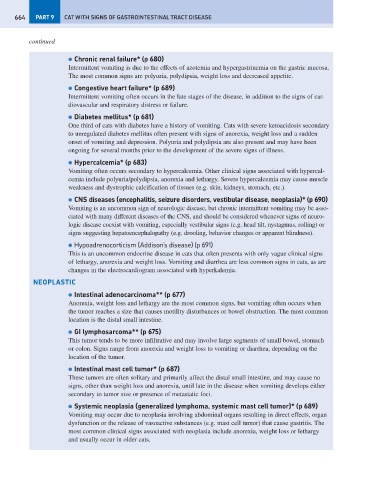Page 672 - Problem-Based Feline Medicine
P. 672
664 PART 9 CAT WITH SIGNS OF GASTROINTESTINAL TRACT DISEASE
continued
● Chronic renal failure* (p 680)
Intermittent vomiting is due to the effects of azotemia and hypergastrinemia on the gastric mucosa.
The most common signs are polyuria, polydipsia, weight loss and decreased appetite.
● Congestive heart failure* (p 689)
Intermittent vomiting often occurs in the late stages of the disease, in addition to the signs of car-
diovascular and respiratory distress or failure.
● Diabetes mellitus* (p 681)
One third of cats with diabetes have a history of vomiting. Cats with severe ketoacidosis secondary
to unregulated diabetes mellitus often present with signs of anorexia, weight loss and a sudden
onset of vomiting and depression. Polyuria and polydipsia are also present and may have been
ongoing for several months prior to the development of the severe signs of illness.
● Hypercalcemia* (p 683)
Vomiting often occurs secondary to hypercalcemia. Other clinical signs associated with hypercal-
cemia include polyuria/polydipsia, anorexia and lethargy. Severe hypercalcemia may cause muscle
weakness and dystrophic calcification of tissues (e.g. skin, kidneys, stomach, etc.).
● CNS diseases (encephalitis, seizure disorders, vestibular disease, neoplasia)* (p 690)
Vomiting is an uncommon sign of neurologic disease, but chronic intermittent vomiting may be asso-
ciated with many different diseases of the CNS, and should be considered whenever signs of neuro-
logic disease coexist with vomiting, especially vestibular signs (e.g. head tilt, nystagmus, rolling) or
signs suggesting hepatoencephalopathy (e.g. drooling, behavior changes or apparent blindness).
● Hypoadrenocorticism (Addison’s disease) (p 691)
This is an uncommon endocrine disease in cats that often presents with only vague clinical signs
of lethargy, anorexia and weight loss. Vomiting and diarrhea are less common signs in cats, as are
changes in the electrocardiogram associated with hyperkalemia.
NEOPLASTIC
● Intestinal adenocarcinoma** (p 677)
Anorexia, weight loss and lethargy are the most common signs, but vomiting often occurs when
the tumor reaches a size that causes motility disturbances or bowel obstruction. The most common
location is the distal small intestine.
● GI lymphosarcoma** (p 675)
This tumor tends to be more infiltrative and may involve large segments of small bowel, stomach
or colon. Signs range from anorexia and weight loss to vomiting or diarrhea, depending on the
location of the tumor.
● Intestinal mast cell tumor* (p 687)
These tumors are often solitary and primarily affect the distal small intestine, and may cause no
signs, other than weight loss and anorexia, until late in the disease when vomiting develops either
secondary to tumor size or presence of metastatic foci.
● Systemic neoplasia (generalized lymphoma, systemic mast cell tumor)* (p 689)
Vomiting may occur due to neoplasia involving abdominal organs resulting in direct effects, organ
dysfunction or the release of vasoactive substances (e.g. mast cell tumor) that cause gastritis. The
most common clinical signs associated with neoplasia include anorexia, weight loss or lethargy
and usually occur in older cats.

